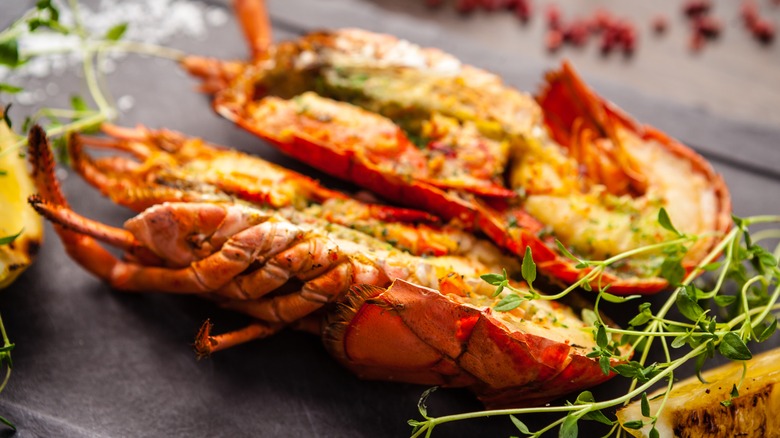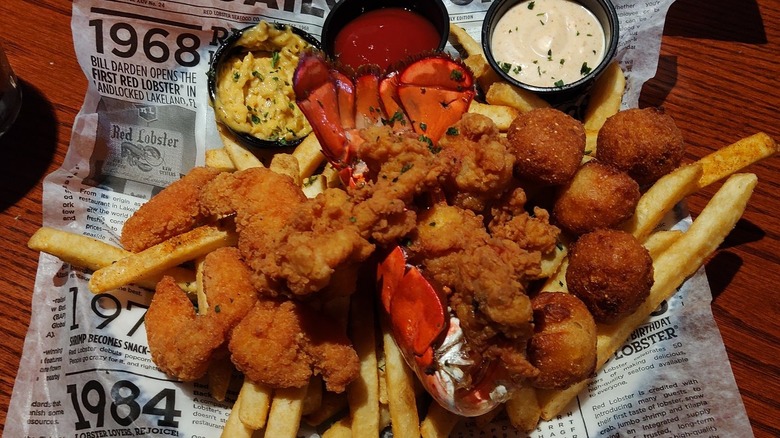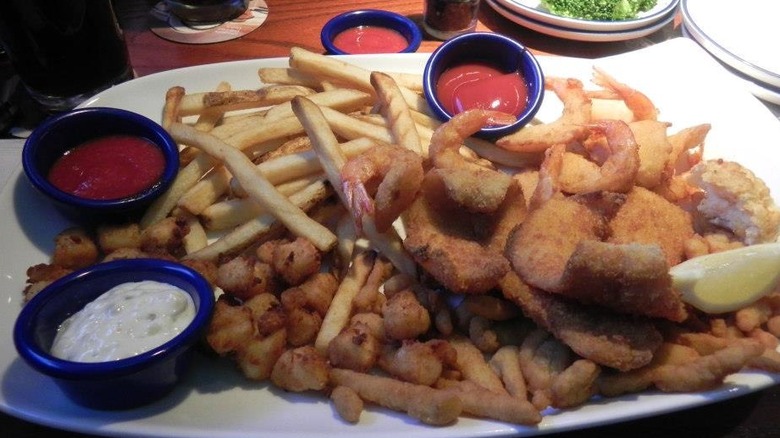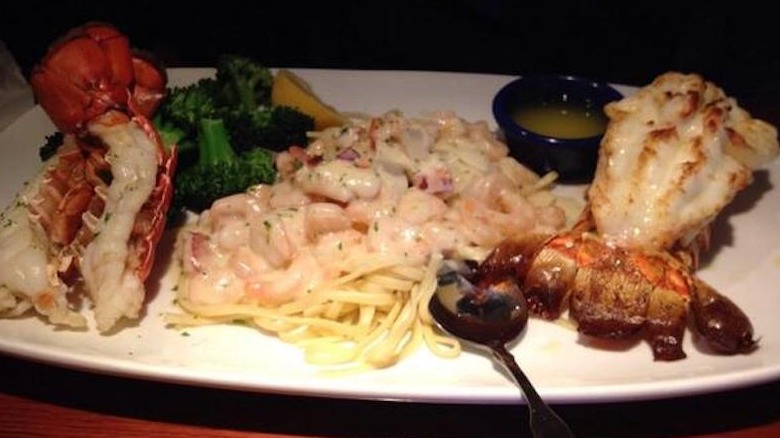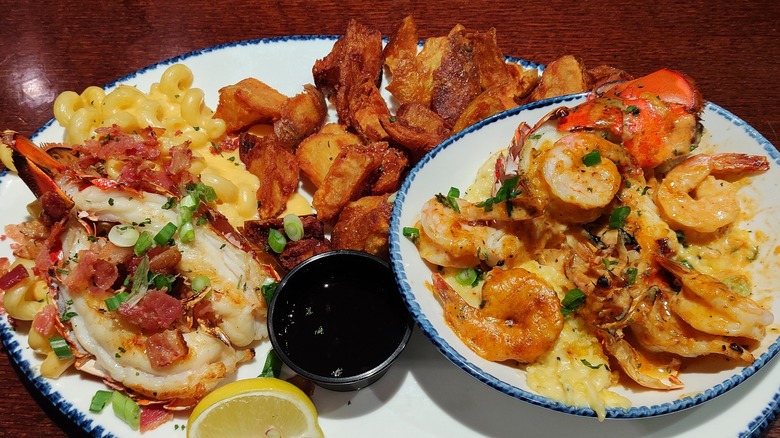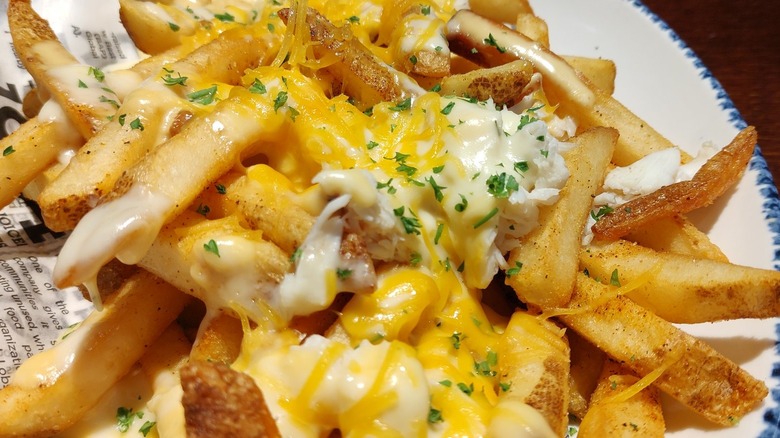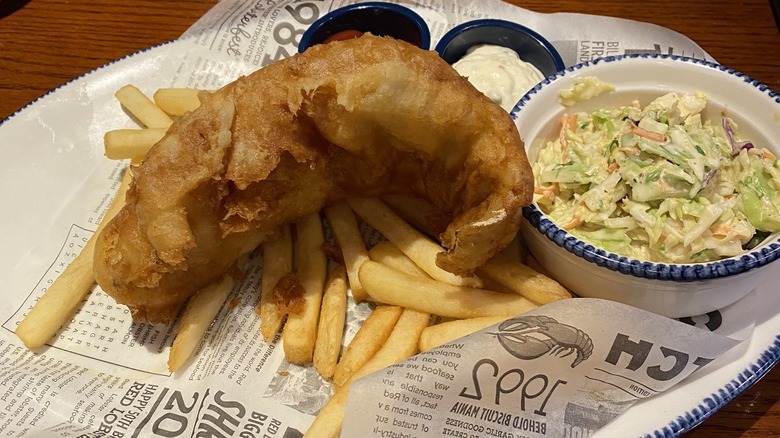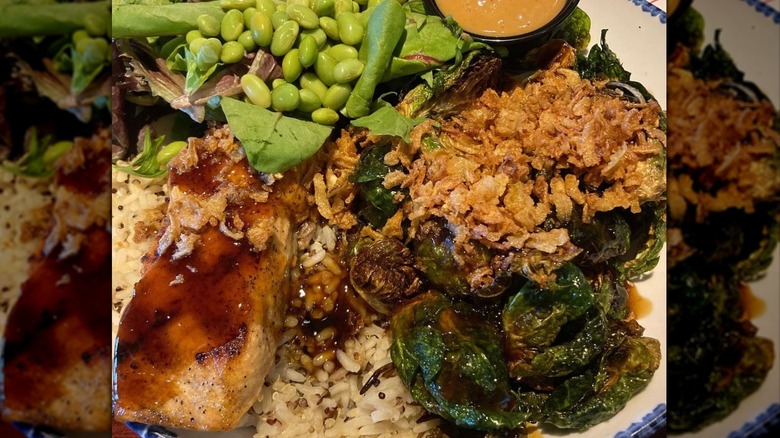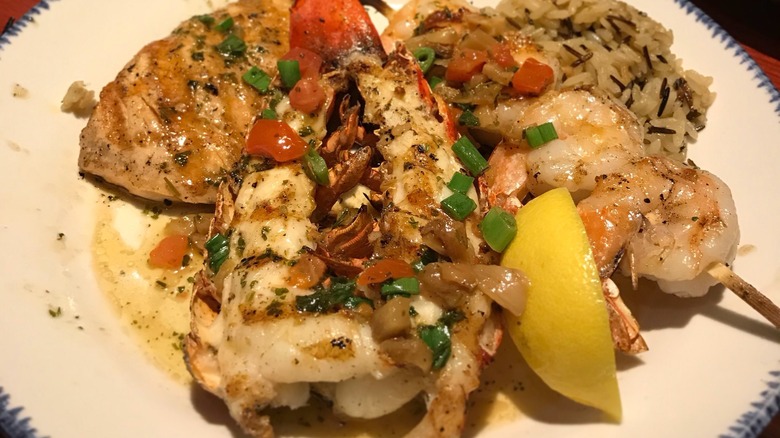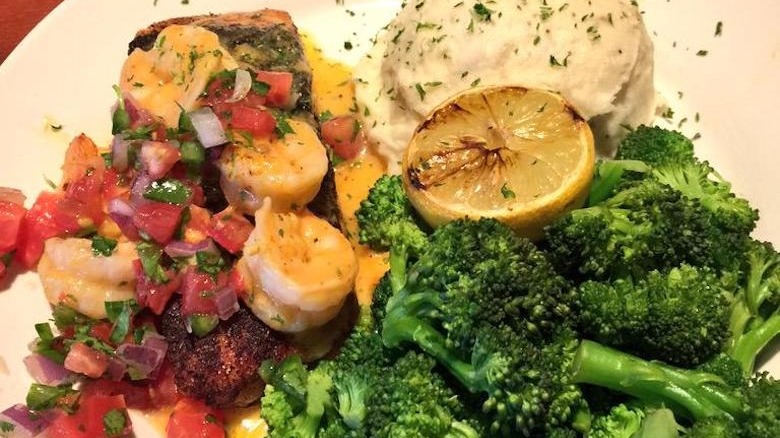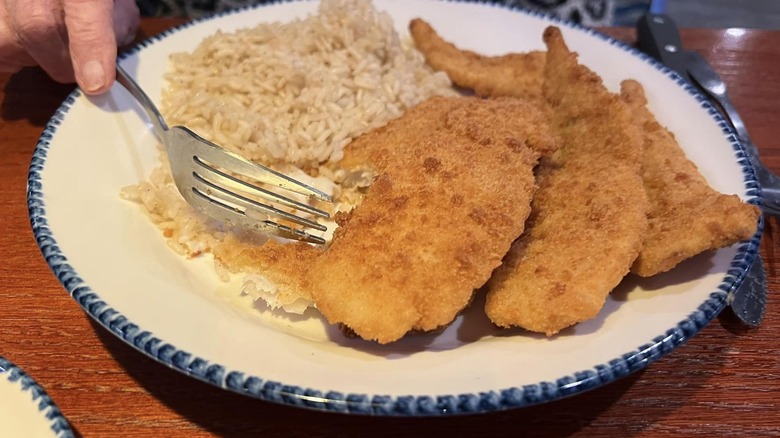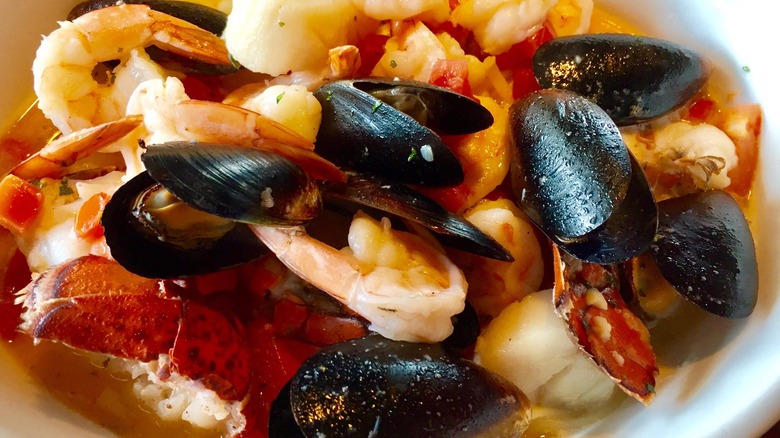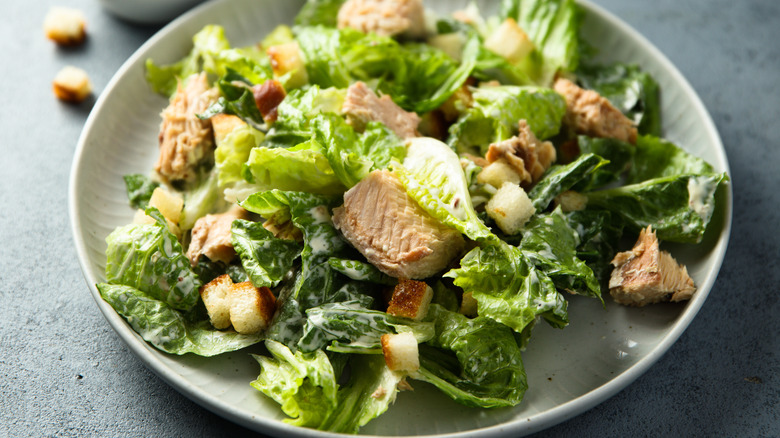13 Unhealthiest Fish Dishes At Red Lobster
Red Lobster enjoys a reputation as a place where seafood shines — fresh from the oceans and straight to the plate, along with sides, appetizers, and those Cheddar Bay Biscuits to make a filling meal for special occasions. Customers may also believe on some level that Red Lobster is a healthier option than other reasonably priced chain restaurants, as fish is naturally abundant with protein and relatively light in calories and fat, particularly saturated fat.
That's true, but a lot of the health benefits of seafood are undercut by Red Lobster's preparations and presentations. The chain's customers often don't have an exact idea about what goes into each dish beyond the broad and tantalizing menu description. Many menu items are prepared with significant amounts of cream, butter, oil, cheese, salt, and breading. Those ingredients make the meals delicious, but it also means the food may be loaded with calories, fat, cholesterol, and sodium.
The U.S. Department of Agriculture (USDA) advises Americans to consume around 2,000 calories per day, and provides guidelines for other dietary elements, recommending daily caps of 65 grams of fat, 300 milligrams of cholesterol, and 2,400 milligrams of sodium — estimates for the average adult of an average build. Many Red Lobster items contain not only well over a meal's worth of those figures but an entire day's or more. By that metric, these are the unhealthiest fish-based items at Red Lobster.
1. Crispy Lobster and Shrimp Stack
Among the newest additions to Red Lobster's Lobsterfest special menu is a massive platter the seafood chain calls the Crispy Lobster and Shrimp Stack. It starts with buttery lobster tail meat that's fried and crispy, surrounded by a sizable portion of similarly breaded and fried shrimp. Red Lobster serves the Stack with several hush puppies — fried balls of seasoned dough — as well as french fries, mayonnaise-laden coleslaw, honey-jalapeño butter, and malt vinegar aioli for dipping.
This opulent collection is so densely packed with calories that it could provide the average adult with all of their basic nutritional needs for more than a day, and enough fat for more than two days. The Crispy Lobster and Shrimp Stack boasts the highest calories of any item regularly on offer at Red Lobster. It's got 2,520 of them (more than the USDA-recommended 2,000), as well as 138 grams of total fat — about double the advised daily allowance. The Crispy Lobster and Shrimp Stack is also an extremely salty choice. It's made with 7,140 milligrams of sodium, or around three times what an adult needs in a day.
2. Admiral's Feast
One of the most voluminous meals on the Red Lobster menu — the name is no understatement — is the Admiral's Feast. It's a bounty of fried seafood, as diners who select this Signature Feast receive full or nearly-full-size portions of four items: Walt's Favorite Shrimp, thin and crispy wild flounder, bite-size bay scallops, and clam strips. All of that seafood is breaded and deep fried, and the meal comes with various thick and sugary sauces and two side dishes.
The dips and accompaniments aren't included in the nutrition facts for the Admiral's Feast, meaning the hefty numbers don't fully reflect what the Red Lobster customer consumes. Just the seafood in this single meal provides the average diner with close to a full day's dietary needs, or more. The Admiral's Feast packs 1,640 calories, 96 grams of fat, and 4,750 milligrams of sodium — that's twice the advised daily limit of salt.
3. Lobster Lover's Dream
Red Lobster lures in customers with a name promising plentiful amounts of a luxurious, expensive shellfish, but it also spotlights the seafood during its frequent Lobsterfest promotions. One contemporary addition to that lobster-centric part of the menu is the aptly named Lobster Lover's Dream. Offering lobster in about as many different ways as can fit on a plate, the menu item pairs a couple of sides of the diner's choosing with three portions of lobster. The meal comes complete with both Caribbean rock lobster and Maine lobster tails. Rounding out the hearty feast is a bowl of linguini, tossed in a thick cream sauce with shrimp and even more lobster.
All of the butter used in the preparation of the lobster tails, plus the cream and carbohydrates in the pasta dish, ramp up the calorie count. Befitting an entree that's really three entrees, the Lobster Lover's Dream contains 1,570 calories and 110 grams of fat — more than the USDA-cited needs for the former and almost double the latter. The 590 milligrams of cholesterol is two-thirds of what an adult can handle in a day, while the 4,460 milligrams of sodium contributes right under two days' worth of salt.
4. Dueling Southern Tails
There's nothing inherently unhealthy about lobster, but depending on how it's cooked or prepared, the calories, fat, and sodium levels can quickly accumulate. Take the Dueling Southern Tails, for example, a selection on Red Lobster's Lobsterfest menu. The cooks at the seafood chain use lobster tails as a foundation for two towering monuments to calories. Half of the plate arrives occupied by a Maine lobster tail, served on top of a bed of creamy grits. Then, all that gets covered with shrimp, treated with a sugary glaze. The other part of the duel is a second lobster tail, dropped atop a big portion of gooey macaroni and cheese. A thick, sweet sauce made from bacon and bourbon serves as a final touch.
The total calorie count for this carbs-and-seafood mash-up is 1,490. The Dueling Southern Tails also provides far more than enough fat and sodium for the average adult's entire day, with 94 grams and 4,510 milligrams, respectively.
5. Crabby Cheese Fries
In theory, appetizers are supposed to prepare a diner for the meal at hand, providing a taste of what's to come without leaving them too full. Sharing an appetizer with one's dining companions is a great way to sample the menu and keep the mood festive without getting too loaded down to enjoy the rest of the meal. But you can certainly enjoy an appetizer alone, and Red Lobster offers many largely portioned options on its Starters menu, such as the Crabby Cheese Fries.
It's a straightforward dish that consists of just a few simple ingredients, most of which don't enjoy a reputation for their health benefits. The Crabby Cheese Fries is exactly that — a big plate of french fries, studded with lump crab meat and topped with both a cheese sauce and a garlic cream concoction. While technically an appetizer, the Crabby Cheese Fries registers figures in calories, fat, cholesterol, and sodium similar to that of many Red Lobster meals. Along with 1,450 calories, it's got 76 grams of fat, 140 milligrams of cholesterol, and 3,760 milligrams of sodium.
6. Fish and Chips
Red Lobster isn't all heaping piles of seafood-laden pasta, overflowing variety plates, and modern, chef-inspired cuisine. Nestled in the Classics section of its menu is arguably the most familiar and iconic seafood combo of all time: Fish and Chips. Red Lobster presents a faithful take on the British takeout staple, offering a generous slab of wild cod fried in a light batter to provide a crispy finish, alongside a moderate portion of fries, a bowl of coleslaw, and tartar sauce for dipping.
Consumed as written and recommended, with the coleslaw and fries (or "chips," in British parlance) on the side, Red Lobster's Fish and Chips platter is as salty and fatty as it is unpretentious. Under the USDA's daily diet recommendations for adults, the meal is responsible for over half of a day's calories and an entire day's fat, with 1,230 and 65 grams respectively. The dish provides just under half of the cholesterol limit (130 milligrams) and more than 120% of sodium needs (2,910 milligrams).
7. Sesame-Soy Salmon Bowl
Counter to its many menu options that are exorbitantly high in calories and fat, Red Lobster has made strides in creating dishes that could be perceived as healthier than the usual restaurant fare, thus attracting more diners with restrictive diets. One of the most seemingly healthy items on its menu in the lunch-leaning Bowls and Sandwiches section is the Sesame-Soy Salmon Bowl. Compared to other items on that same laminated page, the fish doesn't appear to be fried or breaded, and it's served with orzo rice and two vegetables (a spring mix salad and crispy Brussels sprouts), rather than potatoes or coleslaw.
Looks can be deceiving, however, as the Sesame-Soy Salmon Bowl involves so many sauces that any healthy ingredients are overwhelmed by the calorically dense additions. The central protein is Atlantic salmon, which due to its intentionally bulky diet in a farmed setting, results in more calories and about twice as much fat as a similar serving of its wild-caught counterpart. That salmon then gets drenched in a sweet soy and ginger glaze, while added fat makes the Brussels sprouts so crispy. A vinaigrette dressing and crispy fried onions turn that salad into a fat bomb. Altogether, the Sesame-Soy Salmon Bowl contains 1,220 calories, 62 grams of fat, and 2,770 milligrams of sodium.
8. Grilled Lobster, Shrimp, and Salmon
Certain menu keywords can speak volumes about a chain restaurant's fare. If the words "crispy" or "crunchy" appear in the item's name or description, it's a safe bet that it's going to be something heavily battered and deep-fried. On the other hand, words like "roasted" or "grilled" imply that a dish is likely free of those calorie-rich coatings and oil baths. By this logic, one could assume that Red Lobster's Grilled Lobster, Shrimp, and Salmon Signature Feast is one of the restaurant's lighter offerings in terms of calories and fat, heavy only on protein coming from three different seafood sources.
In this instance, "grilled" is a misleading word to describe the healthiness of the dish. While the seafood is cooked simply over high heat and offers a robust 76 grams of protein, it's also responsible for the same amount of fat, as well as 1,180 calories and 2,830 milligrams of sodium. The calorie culprit in this dish: the toppings. A Maine lobster tail, a skewer of jumbo shrimp, and a large hunk of salmon all arrive at the table swimming in a thick brown butter sauce.
9. Salmon New Orleans
Red Lobster knew exactly what it was doing when it included "New Orleans" in the name of this Cajun-inspired entree in the Classics section of its menu. Salmon New Orleans evokes the flavors of one of the country's best and most unique food cities with a hefty portion of Atlantic salmon blackened in the spicy Louisiana style. That would be enough for a chain restaurant tribute to New Orleans, but Red Lobster doesn't stop there, throwing several shrimp on top of the salmon. The whole thing is left soaking in a hot, flavorful, Cajun-spiced butter sauce along with a relish starring tomatoes and cilantro.
It's that Cajun butter sauce that puts the Salmon New Orleans into the realm of the unhealthiest dinners to order at Red Lobster. Not even counting the two sides that come with the meal, Salmon New Orleans contains 1,160 calories and more than a day's allotment of fat (76 grams), also exceeding the daily limit for cholesterol (360 milligrams).
10. Wild-Caught Crunch-Fried Flounder
Fish and Chips is a specific thing on the Red Lobster menu, but it's also the idea behind many of the chain's other entrees. The actual Fish and Chips dish is made with fried cod, while the Wild-Caught Crunch-Fried Flounder is created with a different mild-flavored whitefish. It's battered with a mixture that results in a crispier texture, and it's served in a thin filet. Although the Wild-Caught Crunch-Fried Flounder looks like it might harbor significantly fewer calories than Red Lobster's large and thick fried cod, it doesn't.
Red Lobster's nutrition facts for the Fish and Chips include the fries in its sky-high calorie count; that's not the case for the Wild-Caught Crunch-Fried Flounder. On its own with no sides included, the lunchtime portion of the crispy, browned, and oil-cooked flounder provides a diner with a major part of their food needs for the day. It breaks down to 1,140 calories, 71 grams of fat, and 140 milligrams of cholesterol. The 3,060-milligram sodium tally is also more than an adult should healthily consume daily, per the USDA.
11. Bar Harbor Lobster Bake
Calorie-conscious diners ought to avoid the pasta section of chain restaurant menus. Noodles of all kinds are made almost entirely of caloric carbohydrates, and major restaurant companies, Red Lobster included, tend to serve massive portions of the stuff along with an abundance of butter or a creamy, cheesy white sauce. Nestled in Red Lobster's Pasta offerings is the Bar Harbor Lobster Bake, which prompts thoughts of a beachside clambake or crab cookout. This isn't quite that but a fat-filled pasta dish with a pile of seafood along for the ride. The entree begins with a big bowl of linguini slathered in a garlic and white wine sauce. Also in the mix are a couple of petite Maine lobster tails as well as mussels, tiny bay scallops, and fresh tomatoes.
Added up, this light-seeming pasta and seafood choice meets more than half of the average adult's caloric needs, according to the USDA, with 1,100 calories total. The 54 grams of fat just about hit the recommended one-day limit of 65 grams too. As far as cholesterol and sodium are concerned, the Bar Harbor Lobster Bake exceeds the daily recommendations, with 380 milligrams and 3,340 milligrams of each.
12. Classic Caesar Salad with Atlantic Salmon
Two foods that are generally considered to be healthy choices: salad and grilled fish. One starts from a foundation of raw vegetables and the other is unadorned seafood, a source of protein and omega-3 fatty acids. The worst thing one can do with a salad is cover it with ingredients that aren't vegetables, like parmesan cheese, croutons, and a creamy dressing. That turns a pile of chopped romaine lettuce into a Caesar salad, which Red Lobster offers on its menu as a side and starter, as well as in an entree size. Red Lobster diners can adapt the Classic Caesar Salad into a proper meal by adding protein. Surprisingly, choosing Atlantic Salmon (over chicken or shrimp) adds the most calories and fat.
Even though it looks like a plate of raw vegetables with fish on top, Red Lobster's Classic Caesar Salad with Atlantic Salmon is one of the biggest calorie and fat sources on the menu. It contains 1,070 calories, 81 grams of fat, 180 milligrams of cholesterol, and 1,700 milligrams of sodium. To the average American adult and their nutritional needs, this option is no different than many of Red Lobster's platters of fried and breaded seafood.
13. Crispy Dragon Shrimp
Seemingly inspired by the sweet-and-sour shrimp main dish found at countless neighborhood Chinese-American restaurants for decades, this unhealthy item is merely an appetizer at Red Lobster. But customers receive such a generous portion of the Crispy Dragon Shrimp that nutritionally, this starter can go head to head with some of the chain's full seafood platters. Seafood is naturally low in calories, but a coating of batter adds lots to the total. Frying in oil adds both fat and calories, as does tossing and dressing the resulting crispy seafood in a thick, syrupy sauce.
That's what the Crispy Dragon Shrimp is — standard-issue shrimp bites rolled in enough batter to be extra crunchy. Also, the whole thing is covered in a very sweet and slightly hot sauce, made mostly from sugar and chilis. All that coating, oil, and sauce make for an appetizer with more than a meal's worth of nutrition. The Crispy Dragon Shrimp adds 1,010 calories, 72 grams of fat, 200 milligrams of cholesterol, and 2,010 milligrams of sodium to your Red Lobster experience.
